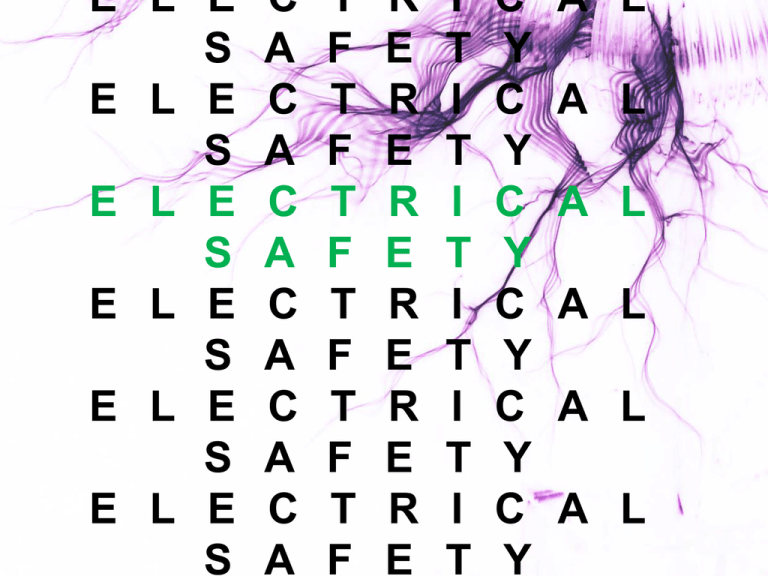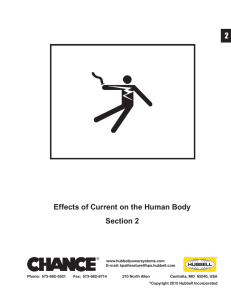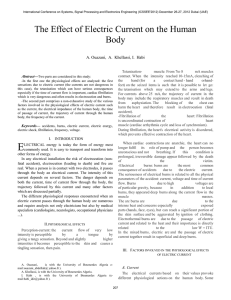Electrical Safety slides
advertisement

E L E S E L E S E L E S E L E S E L E S E L E S C A C A C A C A C A C A T F T F T F T F T F T F R E R E R E R E R E R E I T I T I T I T I T I T C Y C Y C Y C Y C Y C Y A L A L A L A L A L A L E L E C T R I C A L S A F E T Y September 28, 2014 Leo Koppel (QSET) This talk is for your awareness. It is not required, nor does it certify or qualify you to do anything. S H O C K “High voltage is dangerous” “Voltage isn’t dangerous, current is” ? S H O C K Depends on • Current • Pathway through body • Nature of electrical source • Duration • (and voltage) Los Angeles Times. Jun 29, 1902 • Body becomes part of circuit • Danger from – Burns – Cardiac arrest / filbrilation – Fractures / trauma from secondary falling down T. Lanzisero. Electric Shock Hazards - Risk Assessment and Safety Management (2012) C U R R E N T Current Level (AC 60 Hz) Effect 1 mA Sensation that shock is occurring 5 mA Upper limit of safe or harmless range 10–20 mA Let-go threshold: flexor muscles are stronger than the extensor muscles; subject cannot shake loose from the shock source; perspiration 30–40 mA Tetany: sustained muscle contraction and cramping 50–70 mA Extreme pain, physical exhaustion, fainting, irreversible nerve damage; possibility of ventricular fibrillation (heart); respiratory arrest with possible asphyxiation 100 mA Ventricular fibrillation (heart) and death if the current passes through the body trunk >100 mA Fibrillation, amnesia, burns, severe electrolysis at contact sites >5 A Little likelihood of survival J.C. Whitaker, The Electronics Handbook 2nd ed. 2005 A C / D C Bodily effect DC AC 60 Hz AC 10 kHz Slight sensation felt at hand(s) Men = 1.0 mA Women = 0.6 mA 0.4 mA 0.3 mA 7 mA 5 mA Threshold of perception Men = 5.2 mA Women = 3.5 mA 1.1 mA 0.7 mA 12 mA 8 mA Painful, but voluntary muscle control maintained Men = 62 mA Women = 41 mA 9 mA 6 mA 55 mA 37 mA Painful, unable to let go of wires Men = 76 mA Women = 51 mA 16 mA 10.5 mA 75 mA 50 mA Severe pain, difficulty breathing Men = 90 mA Women = 60 mA 23 mA 15 mA 94 mA 63 mA Possible heart fibrillation after 3 seconds Men = 500 mA Women = 500 mA 100 mA 100 mA http://www.allaboutcircuits.com/vol_1/chpt_3/4.html S H O C K • “Let go” current – above this you can’t let go (muscles contract) • Interestingly, domestic AC happens to the most dangerous • Also body impedance is lower • Resistance! Your skin resistance is > 100kOhm dry, but < 1 kOhm wet! C. F. Dalziel, Electric Shock Hazard. IEEE Spectrum (1972) • By the way – I’m not sure why women have a lower threshold; the articles don’t seem to think it’s worth mentioning… • This article is from 1972 • “So far, it has been impossible to obtain reliable values for children; they just cry at the higher values.” • Again, 1972 • (Who among us will fill this scientific niche?) C. F. Dalziel, Electric Shock Hazard. IEEE Spectrum (1972) Also I’ll throw this in… Remember it’s not just lethal shocks we want to Electrical Safety Authority avoid… S O W H A T T O D O ? Working with 24 VDC, our biggest risk is short-circuit -> overheating -> burns or fire. • Watch out for leads • Turn things off before working on them • Don’t wear jewelry / watches when working with power systems S O W H A T T O D O ? • Use multimeter correctly • Watch out for correct socket • Only measure resistance in deenergized circuit • Careful not to short out connections with the leads http://www.allaboutcircuits.com/vol_1/chpt_3/9.html F U S E S • Use the right one • They protect equipment, not you F U S E S https://www.youtube.com/watch?v=YCWdnjLqVWw F I R E https://www.youtube.com/watch?v=YCWdnjLqVWw F I R E • I can’t train you in fire extinguishing.. But • If there’s a fire: warn others! • If you’re not confident the fire can be put out pull the alarm and leave. • Even if you put it out, report it • If something that’s plugged in starts smoking / burning, unplug it first • Lithium batteries are hard to put out / will reignite. https://www.youtube.com/watch?v=YCWdnjLqVWw W E A R T H E S E • When soldering • Working with moving parts • Using tools Exception! • “It’s only for a second” • “My parents have a shop” • “I do more dangerous things all the time” …if you’re this guy! Then it’s okay. Just wear them (QSET has some you can borrow) O T H E R T I P S • Working with the robot or robotic arm know – Where it could move – How you will turn it off • • • • • Be aware of what’s on (and don’t forget) Don’t touch a hot iron Don’t try to catch a falling iron Keep workspace tidy Report incidents http://www.allaboutcircuits.com/vol_1/chpt_3/9.html G E N E R A L S A F E T Y (Leigh Hunter) QSET’s procedures will be posted. Safety! https://www.youtube.com/watch?v=U7Q06csDc7U

![Electrical Safety[]](http://s2.studylib.net/store/data/005402709_1-78da758a33a77d446a45dc5dd76faacd-300x300.png)









